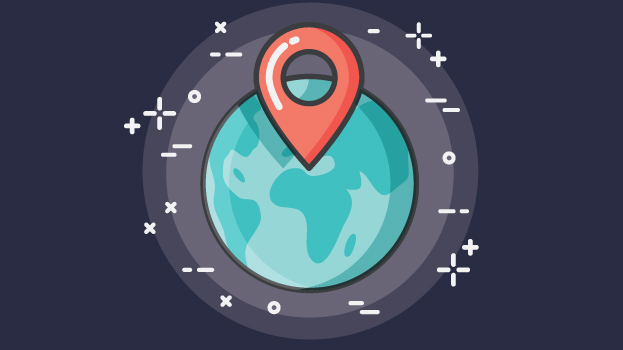Website localisation is the process of adapting the language, appearance and functionality of a website to provide a tailored experience for users.
Whilst customising your biggest marketing tool to your different target audiences should be common practice, this process is usually a step businesses first take when expanding to a new market. Why? Because localisation takes time, effort and money, so a return on investment is paramount.
Since English is considered the international language in business and is also the most common language on the web, it’s no wonder most businesses revert to it when starting out, and sticking to it when expanding. But what if we told you that the English language is only in the lead by a small margin?
In fact, nearly half of all internet users have another native language aside from English. By not taking them into account, many global growing businesses (and their websites) could needlessly be excluding a significant portion of their audiences, which could hinder their profits and expansion plans.
Want to know how localisation can help you avoid losing out on potential customers? Curious to find out how web localisation can influence your cross-cultural success? Read on! But first let’s clarify…
What Is The Difference Between Translation & Localisation?
Most people see “localisation” and “translation” as the same process, but in reality, localisation goes beyond translation.
Translation refers to the literal process of translating words or text from one language to another. This is useful when dealing with contracts and legal documents that require perfect accuracy.
But when it comes to marketing collateral & communication, word-for-word translation can paradoxically suppress the text’s meaning. This is why translation is often not enough when wanting to “speak” to different target markets around the world.
Although translation is most certainly a component of localisation, localisation has a more holistic approach in which content is adapted for a specific audience.
When localising, there is a need to adapt the message from one language to another while maintaining its intent, style, tone and context.
Localising goes beyond language, and also considers culture. For instance, although Spain & Mexico both speak Spanish, each country has its own cultural background, language cues and expressions that are unique to them. Same goes for Australia, the US & the UK, which all speak English, but have VERY different cultural experiences.
With that in mind, as our world becomes more and more interconnected and fast-paced, web localisation has become a crucial exercise (and even an expectation), especially if you’re in e-commerce or looking to take your business global.
A Quick Look At Language & Behaviour On The Web.
Regardless of how big your business is, if your target audience is global and you haven’t yet localised your website, you’re most certainly missing out on attracting, converting and retaining web users and customers.
Indeed, according to Statista statistics, as of January 2020, 25.9% of users choose English as their preferred language on the web. This means that close to 75% of users don’t!
“Can’t read, won’t buy”
In addition to this, the latest survey from CSA Research showed that 76% of global consumers preferred buying products in their native language and 40% will never buy from websites in other languages.
As access to the web continues to spread further into countries where English is not the native language, there is no doubt localising your website is becoming more critical. In fact, from our experience helping countless businesses expand & grow internationally, localisation plays an instrumental role in their success across borders.
But don’t just take our word for it… discover top benefits of localising your website below.
What Are The Benefits Of Localising Your Website?
1. Increase your reach & improve user experience
Given that 65% of online users prefer content in their language, even if it’s poor quality, it’s clear that localising your content will enable you to reach a larger, more targeted, audience.
By speaking your customers’ language, not only are you catering to their needs, but you’re also making their lives easier, which enhances their experience on your website, and thus increases the chance of a sale.
These days, we hear a lot about user experience (UX) and even more about UX design. Conversely, we don’t often hear about content as being the driver of user experience.
Indeed, your website can have the best features, most memorable graphics, and even a great personalisation strategy, but without culturally localised content to back it up, the user’s experience will be diminished.
Why? Because when localising your content, you make it more accessible for that market, and consequently, increase customer attraction and retention.
2. Improve SEO
Search Engine Optimisation (SEO) is the art of tailoring your content to help it organically rank higher on search engines. More specifically, it is the process of optimising your online content so that a search engine’s algorithm is more likely to display it at the top of a user’s search results.
In the past couple of years, we’ve seen a spike in the number of roles created around SEO. From Social Media SEO specialists to SEO Content Writers, businesses are investing in SEO to differentiate themselves and garner higher visibility online. This goes to show how important SEO is, but also highlights growing online competition.
Naturally, competition is higher with English keywords because most companies focus on having a solid English website. This means that the majority of global businesses are missing out on the opportunity to rank well in other languages. This is where you have a card to play.
By having a multilingual website, you’re creating more opportunities for it to rank for some of these less competitive keywords, which consequently helps drive more traffic to your site.
3. Establish credibility
When deciding to build a multilingual website, you show your target market that you’re willing to make an effort to meet their needs and adapt to their culture. In a globalised world, this attention to detail and care makes a big difference in the minds of your audience.
However, this is where a lot of businesses fall short. Instead of collaborating with expert translators to localise their content, many jump on free or cheap plugins to translate. Whilst their intent is honourable, businesses often find this method to cause more headaches than anything else as content is often mistranslated, which can be detrimental to their reputation in the long run.
Rather than rely on a quick fix, making the effort to localise (rather than merely translate) your content is of the utmost importance when looking to expand and succeed across borders.
In fact, researching the do’s and don’ts of the market you want to expand to will help build long-term local credibility, which will have a ripple effect on your sales.
4. Increase customer engagement & retention
The importance of making a good first impression holds true even online.
More often than not, if a customer has a poor first experience on your site, whether that be from unintuitive UX or unlocalised content, they are more likely to dismiss your product or service. Regaining their trust or interest is then much more difficult.
After all, your website acts as your online shop front. As such, it’s only natural that if the content is incomprehensible, or worse, mistranslated, users will not feel welcome.
Conversely, if a potential customer feels at ease using your site during their first visit, the chances that they return, and recommend you by word of mouth or through online reviews (which also contribute to your SEO) are higher.
All in all, as you build credibility and users continue to have positive experiences on your website, it is more probable that they will further their interactions with your business in the future. And since we know it’s easier to market and sell to existing clients than to new ones, localising your web content is a no-brainer.
5. Grow your global sales and increase conversion
As most will agree, assuming all of your customers and clients have the same wants, needs and habits is counterproductive, and more often than not, will cost you business.
By that same token, taking for granted that your site’s potential visitors are fluent in your native language is not just arrogant, it can even be harmful to your business. By shutting the door on a significant portion of your audience, you could lose out on both traffic and conversions (aka sales).
The best way to increase your conversions is by making your clients and customers feel special by catering to their needs and habits. A business can easily do this online by making it as easy & efficient as possible for web users to find what they’re looking for.
Whilst this can be achieved through UX design, it’s primarily done through tailored localised content. After all, a website exists primarily as a means for growth through communication. As such, it should speak to your audience’s needs, as well as give them a clear call to action to take next. This is easier to do when speaking their language, both literally and figuratively.
What Are The Benefits Of Outsourcing Your Localisation To A Professional?
Although translating your website using free plugins or software is enticing to lower costs, we wouldn’t recommend pursuing that route. Why? Because software isn’t able to localise, only translate. And even the most proficient of them don’t always get that right either.
If you were to mistranslate your website, you run the risk of confusing your consumer base, as well as diminish your reputation. However, if you choose to partner with native and professional translators specialised in website localisation from the get-go, you can rest easy knowing that your website content is not only accurate, it’s also culturally appropriate.
Whilst peace of mind could be enough reason to outsource your web localisation, it’s also worth noting that the financial investment it requires now will most certainly be made up tenfold through increased conversions and brand awareness.
All in all, although localising your website is an investment, it is a necessary one if you want to present yourself as a key player in your industry. Today more than ever, people consume content digitally & purchase online, which means partnering with a local expert will make all the difference in the long run.
As more and more people get access to the Internet around the world, the more diverse it becomes. Consequently, the need to create a bridge between different people, languages and cultures is crucial for long-term global business success. This is even more poignant post COVID-19, which saw people embrace technology faster than ever before.
While there are many factors to take into consideration when wanting to “speak to the world”, website localisation remains the most effective way to tailor your digital business across cultures. So, what are you waiting for?













 September 30, 2020
September 30, 2020 







